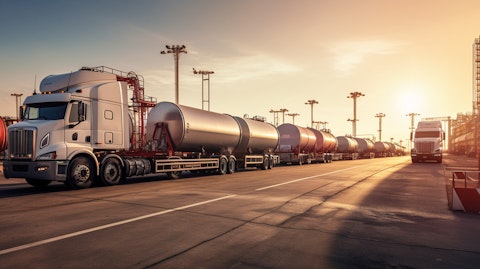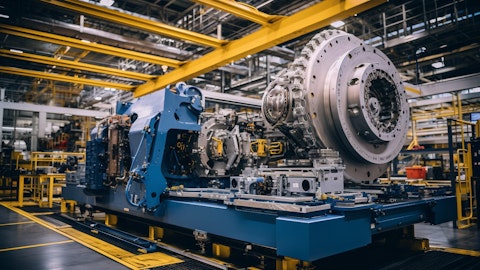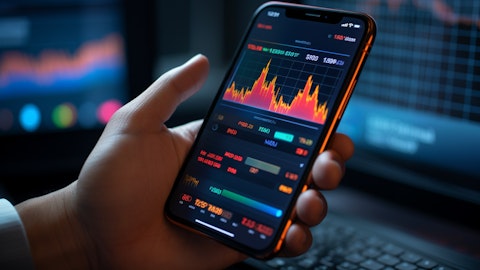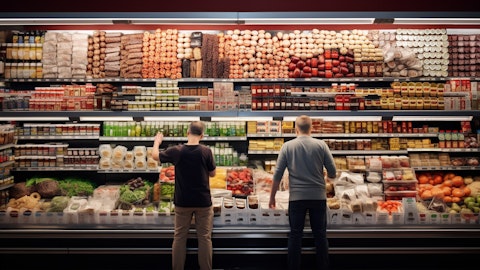Ultrapar Participações S.A. (NYSE:UGP) Q2 2025 Earnings Call Transcript August 14, 2025
Operator: Good morning. Thank you for waiting. Welcome to the earnings release call of Ultrapar to discuss the results referring to the second quarter of 2025. The presentation will be conducted by Mr. Rodrigo Pizzinatto, CEO of Ultrapar; and by Mr. Alexandre Palhares, CFO of Ultrapar. Our question-and-answer session will also have Mr. Leonardo Linden, CEO of Ipiranga; Tabajara Bertelli CEO of Ultragaz; and Fulvius Tomelin CEO of Ultracargo. This call is being recorded, and it may be accessed in the website, ri.ultra.com.br. After the presentation, we are going to start the question-and-answer session when further instructions will be provided. I’d also like to let you know that our conference is being conducted in Portuguese and there is simultaneous translation available through interpretation.
For those listening to the conference in English, you may mute the original volume just listening to the English translation. The presentation will be shown in Portuguese and the version in English is available for download from the website of the company or through the chat. Before moving on, we would like to clarify that forward-looking statements that may be made during this conference call with respect to business prospects of Ultrapar, their forecast, operational and financial goals of the company are all based on beliefs and assumptions of the Executive Board as well as on currently available information. There are no guarantee of performance. They involve risks and uncertainties since they relate to future events, and therefore, depend on circumstances, which may or may not occur.
Investors should understand that general economic conditions, the market and other operational factors may affect the future performance of the company and lead to results which may differ materially from those expressed in these forward-looking statements. I would like now to hand it over to Mr. Rodrigo Pizzinatto, who will start the presentation. Mr. Pizzinatto, you have the floor.
Rodrigo de Almeida Pizzinatto: It is a pleasure to half of 2025 and talk about our achievements and what we are building always focused on the long-term value creation and the development and growth of our businesses. Among the highlights, I want to call your attention to the strong operational cash flow generation, even with BRL 900 million reduction in draft discount due to the IOF tax burden as a result of our disciplined focus on working capital management. Furthermore, we achieved record results at Hidrovias, which has been consolidated into Ultrapar’s financials since May when we became the controlling shareholder after its capital increase. Still regarding Hidrovias, I also reinforced our belief in its potential for growth in value creation.
The stronger results, the reduction in net debt and in the cost of debt, along with all the liability management actions executed after the capital increase already demonstrated part of this plan. And regarding Ipiranga, we recognized BRL 677 million in extraordinary tax credits resulting from the remaining portion of historical ICMS tax credits in the PIS/COFINS calculation basis. We continue to experience illegalities in the fuel sector, including the increase in the regular import of naphtha for selling as gasoline with reduced tax burden and noncompliance with the required biodiesel blend in diesel. On the other hand, there were advances with the implementation of the single-phase taxation of hydrated ethanol for PIS and COFINS in May and the publishing of the list of companies not complying with the RenovaBio program despite the limited effect after injections that prevented the disclosure of certain companies’ names.
I also highlight the evolutions in Sao Paulo state with the start of the tax solidarity principle for resellers and distributors for state tax not collected, a milestone in Brazil’s fight against tax evasion. And at Ultracargo, we completed the construction of Opla’s railway branch and started a gradual ramp-up of operations in Palmeirante in July as part of the company’s expansion, connecting the countryside to the ports with increased exposure to the agribusiness sector. We remain firmly committed to our value proposition, supported by a robust capital structure and a constant pursuit of excellence, maintaining focus and discipline in capital and value creation. We raised BRL 1 billion at Ipiranga at an average cost equivalent to 106% of the CDI, below our current average cost of debt.
In the quarter, we also concluded the buyback program of 25 million Ultrapar shares at an average cost of BRL 16.64. As previously disclosed, we will pay BRL 326 million in interim dividends, equivalent to BRL 0.30 per share in August. And now moving to the next slide. Given the recent proposal under analysis disclosed by ANP, the National Oil Agency regarding changes in LPG regulation, we have also brought some information and data to better support the discussion. Brazil is a global reference in LPG market regulation. We currently have a modern regulatory framework that ensures safety for the consumer by placing accountability on distributors. At the same time, it maintains a highly competitive market where investments in efficiency and growth are essential to profitability and differentiation.
The proposal under analysis by ANP to end brand respect and allow partial LPG refilling endangers both the populational safety and investments in the bottle segment, creating room for illegal activities and organized crime like in Mexico. Over the past 10 years, about BRL 13 billion were invested in the construction, maintenance and requalification of 133 million bottles currently in circulation in Brazil and their respective filling systems. Ultragaz alone invested around BRL 3 billion during this period. And in brand respect discourages investments by distributors. The gradual aging and deterioration of LPG bottles puts population at risk. On this slide, we present some pictures from Latin American countries where brand respect doesn’t exist, such as Mexico and Paraguay, illustrating the severe deterioration of LPG bottles.
Countries that respect the brand, such as Chile and Colombia, maintain LPG bottle products with quality similar to that in Brazil. We also highlight some news about explosions and accidents in countries without brand respect. Furthermore, as I will demonstrate on the next slide, this change will not bring any price benefit either. The current cost of bottle exchange between distributors due to logistical efficiency, scale and proximity between bottling facilities is BRL 0.50 per bottle. Another critical point in this proposal concerns LPG partial filling, which increases logistical costs and the unit price of the product while also creating challenges for inspection, operational risks and volume fraud. And moving now to the next slide, the top chart presents the breakdown of costs and profit per Ultragaz bottle from January to June 2025.
As you can see, Petrobras price of BRL 38 per bottle does not include taxes nor other supply sources like auctions, whose prices are above BRL 38 per bottle nor the primary logistics to deliver the gas to our bottling facilities. As a result, the LPG cost of Ultragaz bottling facility is BRL 60 per bottle, adding the costs of filling, replacing, requalification and maintenance of bottles as well as logistics and commercial expenses and bottle exchange costs. We reached BRL 73 per bottle. I highlight once more the exchange cost of BRL 0.50 per bottle, including all of our administrative and financial expenses and income tax, we add another BRL 4 per bottle. Our total net income to operate in the bottle segment is about BRL 2 per bottle, a small unit margin of 2%, but feasible in Brazil to the scale of our market.
And now in the chart below, we use public data from AMP to show the evolution of prices and margins across the supply chain with figures adjusted by inflation, IPCA. In the first column, we break down the price into producer price, which is mainly Petrobras, taxes and distribution margin. The adjacent column in dark blue shows the final consumer price, which includes freight, costs and margin for 58,000 independent resellers across Brazil. And as you can also observe in the historical series, the distribution margin has remained basically stable, even partially absorbing Petrobras cost increase in 2022. To summarize, we present the conclusions in the box in the right. Society in Brazil does not benefit from these proposals, which, in fact, leads to unintended consequences such as higher logistical costs and reduced safety for the population.

On the other hand, these proposals create space for unlawful players, tax evaders and opportunistic companies that could enter the bottle segment without investing in bottles and filling plants. Therefore, with clarifications and discussions. This proposal should not be implemented. Thank you for your attention. I will now hand over to Alexandre, who will detail the results for the second quarter.
Alexandre Mendes Palhares: Thank you, Rodrigo, and good morning, everyone. Well, first, I’d like to remind you of the reporting criteria and standards used for the analysis that will be made in this presentation, which can be seen in this slide. This specific result has some particularities related to the first consolidation of Hidrovias and includes 3 months from the share of profit on its results in order to eliminate the lag, and we have been carrying as well as 2 months of EBITDA from May and June. Now let’s move to the next slide, where we will see Ultrapar’s results. Total EBITDA reached BRL 2.07 billion that represents a significant growth compared to last year, partially driven by the recognition of extraordinary tax credits.
The recurring EBITDA for the quarter totaled BRL 1.468 billion, representing an increase of 15% compared to the second quarter last year. This performance mainly reflects the consolidation of Hidrovias results and Ultragaz’ better results, which were partially offset by Ipiranga’s lower EBITDA. Considering the sum of the reported EBITDA from our business, we reached BRL 1.541 billion, slightly above last year’s level. The strong performance from Hidrovias and Ultragaz offset Ipiranga’s results. The net income was BRL 1.151 billion in the quarter, an increase of 134% compared to the same period of the previous year, reflecting the higher operating results and the recognition of extraordinary tax credit in the amount of BRL 677 million. The CapEx for the quarter was BRL 544 million.
This represents an increase of 14% compared to last year, mainly reflecting the effect of consolidation of Hidrovias in the amount of BRL 64 million. We had an operating cash generation of BRL 1.848 billion, excluding the BRL 909 million from the reduction of the draft discount, a growth of 73% compared to the same period of last year. This cash generation is explained by the reduction in working capital due to lower diesel and gasoline price and the addition of BRL 138 million related to the consolidation of Hidrovias cash generation. Moving to the next slide to discuss debt and leverage. We ended the second quarter with a net debt of BRL 12.635 billion, which is equivalent to 1.9x net debt to EBITDA for the last 12 months compared to 1.7x in the last quarter.
This increase was due to the reduction in draft discount of BRL 909 million because of the IOS tax burden. Excluding this effect, we would maintain the same leverage level, mainly due to the strong cash generation in the quarter, even with the consolidation of Hidrovias, which added BRL 3.056 billion in the net debt and approximately 0.2 in the total leverage. in addition to the acquisition of additional stake in the company and the buyback share program of Ultrapar, which together totaled BRL 494 million. Well, moving to Ipiranga’s results. The volume sold in the second quarter was 2% lower compared to the second quarter last year. In diesel, there was a 3% reduction, reflecting the irregularities in the biodiesel blend and the import parity opened during most of the quarter, which resulted in an oversupply of products in the market.
The auto cycle decreased 1%, impacted by the growth in irregular imports of naphtha for sale as gasoline. We ended the period with 5,826 stations. We added 54 sub stations and closed 75 to our network throughout the quarter. Regarding AmPm, we ended the quarter with 1,460 stores and revenue growth of 10% in the quarter in the same-store sales concept. Ipiranga’s EBITDA reached BRL 1.199 billion. Recurring EBITDA for the quarter was BRL 678 million, which is 13% down from the previous year. As I mentioned earlier, regular in naphtha and biodiesel blending, the import parity opened and the inventory levels in the market impacted volume and EBITDA, which also had additional impact due to Petrobras price adjustment during the quarter. These effects were partially offset by lower personnel expenses due to a smaller headcount and one-off expenses related to the office relocation that occurred in 2024.
For the third quarter, we expect seasonally stronger volumes. We started the period with a closing import parity scenario and a trend towards normalization of inventories in the industry, which contributes to profitability above that observed in the first half of 2025. Moving to Ultragaz. The volume of LPG sold in the quarter was 1% lower than the second quarter of 2024, with a 2% decrease in bottle segment, reflecting the competitive dynamics of the market affected by the pass-through of increased costs of Petrobras auctions. Bulk volume remained stable. Ultragaz recurring adjusted EBITDA was BRL 442 million in the quarter, 11% higher than the registered in the same period of 2024. These results reflect the better sales mix, greater efficiency in the Bulk segment and greater results from new energies, partially offset by lower results in the bottle segment and higher expenses.
For the third quarter, we expect seasonally stronger volumes and recurring EBITDA slightly above the third quarter of last year, enhanced by the performance of new energy. Going to [indiscernible], the installed capacity remained at 1,067,000 cubic meters in the period. We note that the cubic meters sold decreased 14% year-over-year, reflecting the lower demand for storage and fuels imports affected by industry inventory handling reduction with lower handling in Santos and Itaqui. Net revenue totaled BRL 247 million in the quarter, a reduction of 6% compared to the same quarter 2024, reflecting volumes effect partially offset by a better handling mix. Ultracargo’s EBITDA totaled BRL 141 million in the quarter, which is 15% lower than the same period last year and mainly explained by lower [indiscernible] meters sold and initial costs and expenses with the expansion of Opla and the new terminal in Palmeirante.
For this third quarter, we expect EBITDA in line with that observed in the second quarter. Well, finally moving to Hidrovias and to explain and compare the results, we are considering the entire quarter of Hidrovias that is the same number already released by the company. The total volume in the quarter was 10% higher compared to the same quarter last year. The South corridor stands out, driven by better navigation conditions aligned with the improved rainfall patterns and increased [indiscernible] as well as volume growth in the North corridor. Recurring adjusted EBITDA totaled BRL 348 million in the period, which is 39% increase compared to the second quarter last year. These results reflect improved availability conditions, higher volumes and tariff adjustments in the North corridor.
These effects were partially offset by lower results from Cabotage and Santos operations. Recurring EBITDA from Hidrovias consolidated in Ultrapar’s quarterly results totaled BRL 276 million. Of this amount, BRL 234 million refers to Hidrovias EBITDA for May and June. Following the consolidation of control and the remaining BRL 42 million refers to the same — the share of profit for the pre- consolidation period. For the third quarter, as disclosed by Hidrovias, we expect a continued strong results, a significant increase in recurring EBITDA compared to the third quarter of last year. Well, with that, I conclude the presentation and I’d like to thank you all for the participation. Let’s move to the Q&A session. But before we start, just to contribute to the dynamics of this moment, I would like to reinforce that questions related to Hidrovias will be answered from the perspective of the controlling shareholders.
Any other operational details should be directed to the Hidrovias IR team. Thank you.
Q&A Session
Follow Ultrapar Participacoes S A (NYSE:UGP)
Follow Ultrapar Participacoes S A (NYSE:UGP)
Receive real-time insider trading and news alerts
Operator: [Operator Instructions] The first question comes by Gabriel Barra with Citi.
Gabriel Coelho Barra: And I have 2 questions. The first one, I think you pointed out quite well in the release and Pizzinatto talked about the informal practice and the margins in the industry. Even though there has been an impact in terms of margin for you, we’ve seen some improvement. There is the single phase taxation, RenovaBio. We can see some significant improvement, solidarity, a number of things happening, good things for the industry. So I would like to hear more about the dynamic of margins. Is it within what you had expected, considering your inventory levels. I’d like to hear more about that and how you can see the margins considering all the different movements involving in formal practice and what we can expect from now on in terms of this change in the industry?
Now Ultragaz, you’ve talked about regulation, which is something very important. The one side, we have the Brazilian petroleum agency discussing ANP. There is also a discussion about the law of gas to all but a lot has been said about LPG especially addressed by Petrobras. Considering competition in the industry, a lot has been said about having Petrobras back into the LPG industry. Maybe it’s too early, but I would like to hear your opinion about that competition. You are doing quite well in terms of exchange of the bottles and so on. But if Petrobras came back into the market, what would you expect? And how are you getting prepared to a newcomer and a newcomer as big as Petrobras. And finally, in working capital and the draft discount you’ve mentioned, this is very much related with the discussion of IOF, the tax on financial operations.
The idea was to exclude the draft discount or once there is a definition about IOF, do you think that there would be draft discount back again into your working capital. So what can we anticipate for the next quarter?
Leonardo Linden: Good morning, Gabriel. This is Linden speaking. You have a number of questions, so different people will answer them. In terms of regulation, you’ve got it right. Yes, there are very important movements going on. I think we should highlight the 3 main ones. First, the single-phase taxation pointed out by Rodrigo. The single-phase taxation has a practical effect, which is negative at first because we deteriorate the margins. But then it gets picked up with time. And we see it as positive, positive effect. Then the CBIO’s of the 3 elements that I’m going to mention, the one that makes me more frustrated is exactly that. It’s been a very good movement, trying to get visibility to all of those who are not complying with the program, but there are injunctions, opening junctions that still have to be analyzed.
It’s no sense having an operator in activity for 3 or 4 years, never complying with the rules of the program. So it makes no sense, right? This is something that we still need more visibility to understand how it’s going to be concluded. And finally, solidarity, and I agree. I think that this is a very important thing. We are talking about BRL 210 million of tax debt included to those solidary responsible parties. I hope it can go into other states because only by doing that, we can start inhibiting the tax evasion I can see the effects overall has been positive. In terms of margin, I think it’s too early. It’s too early to anticipate or to imagine what the impact would be. Initiatives are positive. So we expect that to bring positive effects as well in the future.
Tabajara Bertelli: Gabriel, Tabajara speaking. Thank you for the question. The information that we’ve heard in the market. We still do not have many details we can just make hypothesis, right? Petrobras coming into the market. Petrobras is a top quality player. It has already operated in this industry in the past, responsible for consolidating the regulation market, focused on safety. So it would be instrumental to support the consolidation of regulation that we have. It’s a company that would really come into the market and really play by the rules. It’s a player that could come in the market and support everything that is ongoing. We wouldn’t see any changes in terms of the near future. The information that we have is very similar to what you mentioned. We don’t have any further details.
Alexandre Mendes Palhares: This is Palhares speaking. Concerning the draft discount, you got it straight the discussion of the tax on financial operations IOF was the trigger. We have access to long-term funding lines at very competitive rates. We decide to use it to avoid the direct discount, and it’s still a good tool to manage short-term working capital but at lower volumes, right? That’s exactly it.
Rodrigo de Almeida Pizzinatto: Thank you, Gabriel. I would like to emphasize something that Linden pointed out. The solidarity of resellers in paying taxes in Sao Paulo. It’s really a landmark the industry in Brazil. It hasn’t gained as much attention as it deserves. But it’s a transforming factor. It should serve as a role model to other states because it increases a tax collection and it favors taxpayers, such as us, right? I would like to emphasize this point because this is really a turning point in the regulation and inspection in Brazil.
Operator: Next question comes by Vicente Falanga with Bradesco BBI.
Vicente Falanga Neto: Good morning, Linden, the team. I’d like to go back to IR of LPG. Tell us about the exchange of information you have had with the ANP. We’ve read the document. We don’t think it’s very clarifying or quantitative. In your presentation in two of the charts, you showed that may be things would not make that much sense. So what kind of exchange of information have you had? And when will you have opportunity to learn more maybe when there is an initial draft. What can we expect in terms of upcoming steps. And a follow-up on Linden’s comment, it seems there is a legal effort to put an end to all the injunctions of the credits, the bio credits. Do you have any visibility, any anticipation of that?
Rodrigo de Almeida Pizzinatto: Good morning Vicente. Concerning the regulations in LPG, I’m going to bring a point to the discussion, and then Tabajara can build up on it. In the prehearing level because there is also going to be a public hearing. But in the prehearing stage, 247 inputs were made out of which 244 were against the proposal of changes of fractioning and end of the branded product. And there’s opposite position came from the national Commander of the firefighters the International Federation of workers in transportation and other organizations, all of them against fractioning and or the end of the branded bottles. Only 3 out of the 447 only 3 were in favor of that change, but by other organizations, which are not so representative.
Tabajara Bertelli: Tabajara speaking. Rodrigo has given us an overview of what has happened. There has been a preconsultation a prehearing stage. We were very deep into our contribution and inputs, providing arguments, of course, we have just presented a summary to you today. There is a regulatory agenda in place and some of the points, which may be even positive such as release of use rather than restricted use. I mean, there are some positive things should it become into effect. But this is a discussion that is going to be on and on with further participation. And this is why we wanted to share that with you. If you want to get involved — this is the time to do it. We are concerned. Of course, we want the regulation to move ahead, not to take back steps.
And there are many steps still on schedule, and we are going to be part of this discussion. Vicente, concerning the legal effort, yes, there are a number of initiatives providing support and clarification. One of them is a request of the General Attorney’s office of the government but still waiting for the analysis of the Supreme Court analysis. But we are here to support the process and to correct distortion as quickly as possible. We do whatever it takes.
Operator: The next question comes from Matheus Enfeldt with UBS.
Matheus Enfeldt: Robust results once again at Ultragaz. Capital allocation. One is your leverage target that would allow Ultra to start considering opportunities of investments at the holding level. The message is clear. Investments are being made at the level of subsidiaries. You’ve made some very good acquisitions in previous quarters. But thinking about something bigger, maybe as big as Hidrovias, maybe next year where your leverage would go back probably to 1.5. How are you anticipating that. When do you intend to revisit intensively these kind of investments. In terms of LPG margins, we’ve talked a lot about the continuity and robust results. But I would like to understand a — to what extent can you think about other energies within that area or the levels that we’ve been talking about 3% to 5% of share of EBITDA from new energies. Should we still remain and work with this level? Or can we expect anything else?
Rodrigo de Almeida Pizzinatto: Good morning, Matheus. Concerning leverage and considering the higher interest rates, we see leverage at a comfortable level between 1.5 and 2x over EBITDA. In the second half of the year, will be very positive in terms of cash flow. Probably by the end of the year, you’re going to get to the level of leverage that we had in the end of 2024. Even with the investments made to complete our controlling position at Hidrovias, the buyback program and the consolidation of Hidrovias debt of BRL 3.1 billion in the quarter.
Tabajara Bertelli: Tabajara speaking. In terms of share from new energies, we are very much aligned with our plan. Everything that we’ve been referring to in previous quarters. We are still obtaining a lot in combining businesses of our clients, with biomethane, distributed generation, sales, a lot of things going on and very much aligned with the plan that we have developed. In this quarter, we captured efficiency and excellence in our operations of all the strategic initiatives that we have in the long term many of which combined and bringing results that helped us deliver the results for this quarter. Part of our Integration of the consortium was important, impacted our results. This is a continuous process. There has been no discontinuity in the short term projected, and we expect to see that evolution throughout time.
Operator: Next question comes by Eduardo Muniz with Santander.
Eduardo Muniz: Great results. The first question is a follow-up on what we’ve heard. The strategy of reducing the direct discount exposure. Does it involve the gross profit of the company, especially Ipiranga? And what was the share for EBITDA margin by cubic meter in the second quarter? Second question concerns consolidation of Hidrovias. From now on, what can we expect in terms of initiative in terms of cost reduction, G&A and how that can impact the EBITDA of Ultrapar. These are my questions.
Alexandre Mendes Palhares: Thank Eduardo for the question, Palhares speaking. The fact is not relevant. And we use it one-off throughout the quarter, nothing that would really change our perception. What was the second question again? Consolidation of Hidrovias. Should we expect cost reduction, G&A reduction and how that can impact Ultrapar’s EBITDA.
Rodrigo de Almeida Pizzinatto: Good morning. Rodrigo speaking. Concerning consolidation of Hidrovias, we’ve been doing that to allow a better correlation with the market and really focused on our ongoing plan and results of Hidrovias. And that’s going to be addressed by the Hidrovias call. In terms of our controlling holder, Hidrovias has come from a process with better navigability and thanks to all the improvements in management, operations, cost reduction, and improvement of indebtedness level. So we expect the second half of the year, which is going to be much better than last year’s. In further details, I would like to ask you to approach our Investor Relations team of Hidrovias.
Operator: The next question comes from Bruno Amorim with Goldman Sachs.
Bruno Amorim: I have a strategic question concerning Ipiranga and that agenda against informal practice is moving ahead. You always show us clearly the movement. And as the agenda moves ahead, the company’s priority, what will it be? Increased return on investments, ROIC in more market share? What is the current ROIC of Ipiranga in your accounts. Do you think that you are at the right level or not? And I’m asking at the level because a major player has just said that it has been expecting margins at the current level. Just to understand, if you have the same perception right margin, great returns on investment, so competitive gains would be increased volumes from now on.
Rodrigo de Almeida Pizzinatto: Bruno, yes, we expect better market because of improvement in the regulations. It doesn’t change how we consider investments. Investments have to be selective, no matter what. As I’ve mentioned before, we always focus on investments that have a return of about 20%. It’s not at this level yet. So we are not at the level we would like to be, of course, but our plans is, yes. If there is room to have a disciplined investment practice, we are going to look for opportunities as the market improves. And margins are part of that as well if the whole situation improves, margins and volumes equally improve. But we have to be absolutely sure that the regulatory issues are really progressing.
Operator: The next question comes from Bruno Montanari with Morgan Stanley.
Bruno Montanari: I have 2. First, about Ultracargo, could you please tell us more about mid- and long-term perspective concerning the increase of sold cubic meters and some update on your expansion projects. And secondly, capital allocation. Once you reach your target leverage, how would you consider getting into a new business or increasing the distribution of dividends? And what would be the minimum return rate that you would consider to go into a new business line. Well, maybe expand some of our business in some of your business in a more robust fashion.
Fulvius Tomelin: So thank you, Bruno. This is Fulvius speaking. Brazil is an important country. So we have continuous demand we justify our constant investments. In this year, we started the operations in Palmeirante, and we have in our pipeline, the expansion of Santos and Rondonopolis both of them come into their conclusion. The expansions are going through a maturation process with expectations of reaching EBITDA per cubic meter similar to other terminals as of 2026. We just need some maturation for the expansions of Ultracargo.
Rodrigo de Almeida Pizzinatto: Good morning, Bruno, Rodrigo, speaking. Concerning target leverage once we get close to our expected level we are going to consider both options, whether it’s worth investing again to expand existing business or to go into a new business and the return rate will be adjusted by risk. Also what we do. Sometimes we have a return rate which is lower, and that’s what we want to work with. If there are no projects then we increased the dividend payout. There is no previous decision already made. Things are decided as the reality changes.
Operator: Our question-and-answer session is concluded. Now I would like to hand it over to Alexandre Palhares for his closing remarks.
Alexandre Mendes Palhares: Well, let me thank you very much for your time and your participation. Let me remind you that on September 19, we are going to have the Ultra Day. We are highly excited to welcome you all there. We’re going to talk about our strategy and give you more details about our businesses. We are here at your availability. Our Investor Relations team is here to support you. Thank you all very much for your participation.
Operator: Thank you for your time and interest. Let me remind you that the next meeting will be on September 19 at Ultra Day. During the event, we are going to share our strategic view and more details about our businesses. We count on your participation. The Investor Relations team is at your disposal for any follow-up and for questions which may come up. Thank you all very much. [Statements in English on this transcript were spoken by an interpreter present on the live call.]
Follow Ultrapar Participacoes S A (NYSE:UGP)
Follow Ultrapar Participacoes S A (NYSE:UGP)
Receive real-time insider trading and news alerts




